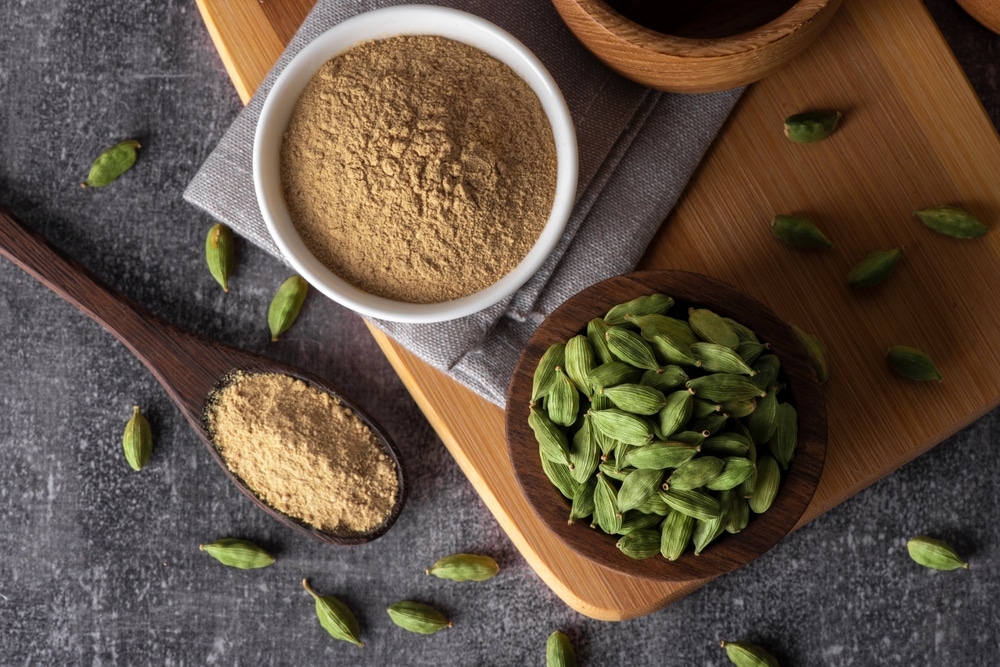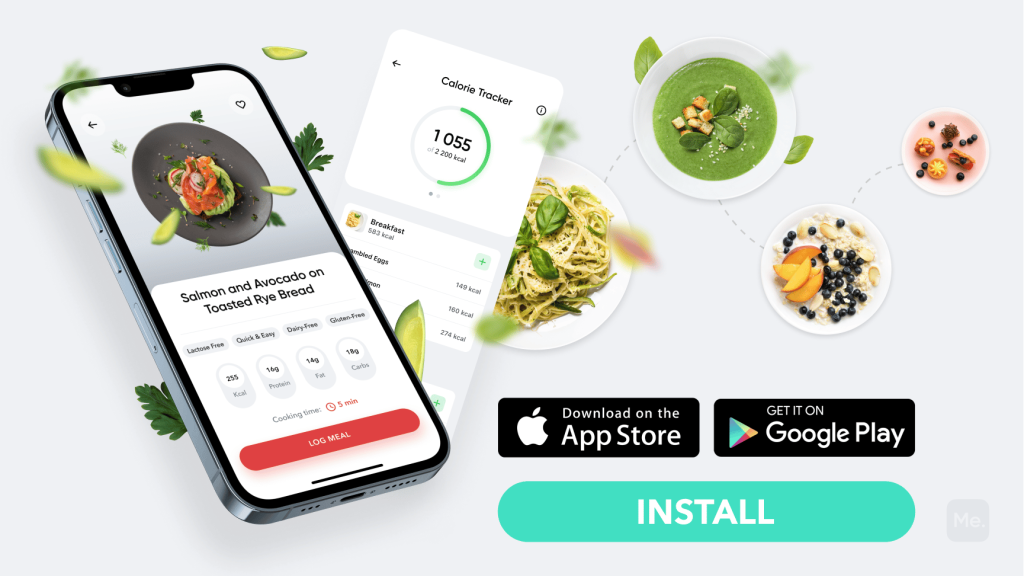Alongside spices like black peppercorns, cloves, cinnamon, cumin and nutmeg, cardamom and coriander are considered to be among some of the warmest spices. When added to foods or sometimes drinks e.g. tea they not only add great flavor, but also have a touch of heat that can warm you from the inside.
Get your personalized
meal plan!
Coriander and cardamom can be found in all kinds of cuisine but are prominent in Indian, Middle Eastern, Mediterranean, South and South East Asian, Mexican, Latin American, Chinese, and African cuisines.
While these two spices are not similar, some people still find it hard to figure out the cardamom – coriander difference and often wonder ‘is cardamom the same as coriander?’. If you fall into this group, then you are in the right place.
In today’s article we shall be taking on the cardamom vs coriander debate. Here, you shall be learning how to properly differentiate these two spices, what they can be used for individually, substitutes for them (if available) and much more.
Is Coriander Similar To Cardamom?
No. Coriander is not similar to cardamom. While they can be used as substitutes of each other in some dishes, the two come from very different plants.
Read More: Healthy Spices List: 13 Flavorful Herbs And Their Health Benefits
The Difference Between Coriander and Cardamom
To better understand the distinction in cardamom vs coriander, we need to dive deeper into the history and physical descriptions of each spice.
Cardamom
Also known as cardamon or by its scientific name Elettaria cardamomum, it is a herbaceous plant from the Zingiberaceae (ginger) plant family. Cardamom is usually included in South Asian curry dishes and can also be found in Scandinavian pastries.
This plant’s origins can be traced back to South Indian forests where its fruits can be collected from wild plants in the forests still today. In the West, this spice was introduced in Europe in the mid-16th century. Today, most of the world’s cardamom comes from India, Sri Lanka, and Guatemala.
In terms of physical appearance, the cardamom plant can grow anywhere between 5 to 20 feet and bears greenish petals and a purple-veined white lip. The cardamom fruit – a green three-sided oval capsule containing 15 to 20 dark, reddish brown to brownish black, hard, angular seeds – comes from these flowers.
You can find this spice as either whole or ground dried fruits or seeds (4). Two cool random trivia facts to know include
- There are two varieties of cardamom – black and green. The green variety is the most common and is said to have a milder flavor as compared to the black variety which has quite the aromatic and smoky flavor.
- Green cardamom is among the world’s most expensive spices by weight. Other spices in this list include saffron (most expensive), vanilla, turmeric, nutmeg and black pepper, among others.
What Is Cardamom Used For?
The most common use for this spice is as a flavoring for multiple dishes such as curries, desserts, and as well as a variety of meat dishes. Cardamom is also often added to beverages such as coffee and tea. If you happen to have run out of this spice and a recipe calls for it, you can easily substitute cardamom with either nutmeg, cinnamon, coriander seeds, or allspice.
Aside from its use as a flavoring spice, ccardamon can also be taken for its potential health benefits. Over the years, several studies done on both human being and animals have shown that this spice may have some incredible health benefits namely
- Improved heart health – The findings of a study done on lab rats and published in the Journal of the Science of Food and Agriculture showed that cardamom oil can help reduce cholesterol and triglyceride levels in rats with high cholesterol (2).
- Improved oral health and bad breath – In a study published in 2020, researchers found that both cardamom seeds and fruits may be effective in the prevention of gum infections and disease. They concluded that this spice’s possible ability to improve oral health comes from its anti-inflammatory and antioxidant properties (1). This spice can also be found on the ingredients list of many chewing gums
- Treatment/management of non-alcoholic liver disease – Abbreviated as NAFLD, this is a condition that occurs when there’s too much fat build up in the liver.
A double blind study done on overweight or obese patients with non-alcoholic fatty liver disease found that patients who took green cardamom supplements had improvements in their liver health markers as compared to those who only took a placebo.
Researchers found that green cardamom significantly increased serum Sirtuin-1 (Sirt1) and decreased tumor necrosis factor-alpha (TNF-α), high sensitive c-reactive protein (hs-CRP), interleukin-6 (IL-6), and alanine transaminase (ALT) (13).
- May have cancer fighting properties – While this hasn’t been confirmed in human beings, multiple studies done on lab mice have shown that it may be protective against skin cancer (5, 3).
- May ease digestive issues – Like ginger, cardamom might help ease digestive issues like nausea and vomiting. Studies in rats have also shown that this spices’ extract – mixed with other plant extract like sembung leaf and turmeric – can prevent or reduce stomach ulcers (11, 12).
If you wish to cinch your waist, tone up your bat wings, blast away the muffin top – our fitness app was created to cater to all your needs! BetterMe won’t give excess weight a chance!
Coriander
While cardamom is part of the ginger family, coriander (also known as cilantro in some parts of the world) is a feathery annual plant of the Apiaceae (parsley) family. Coriander plants are pretty short and low to the ground as they only grow to about 1 to 1.25 inches high.
Coriander, native to both the Mediterranean and Middle Eastern regions produces small pink or white-ish flowers which later form into a small oval shaped yellow-brown fruit that has about 2 seeds inside. The seeds are said to have a mild fragrance and a taste that is similar to a combination of lemon peel and sage (7).
Fun facts about coriander include:
- Coriander is among the very few plants that are considered both a spice and a plant.
- While the terms coriander and cilantro tend to be used interchangeably, coriander actually refers to dry fruits and seeds, while cilantro refers to the leaves.
- Aside from the roots all parts of the cilantro/coriander plant can be used in cooking. While many people in the West only use the seeds and sometimes leaves in cooking and garnishing, respectively, most African, Latin American, Chinese and Indian dishes will often have both the stem (especially young stems) and leaves.
- The seeds have a subtle nutty flavor while the leaves (and young stems) have a bright citrus-like flavor.
What Is Coriander Used For?
The uses of this herb can be traced as far back as 5000 BCE and the Romans are known to have used it as both an aromatic and a carminative – a drug to prevent flatulence. Today, this plant is mostly used just to flavor food.
In middle Eastern cooking, it is often used alongside other spices like cumin and cinnamon. It should be noted that the seeds are usually too tough to chew so to make them more palatable, you are advised to first toast and grind them before adding them to your stew or curry dishes or baked goods. Or simply buy ground coriander.
If a recipe calls for herb but you do not have it some coriander substitutes you can use include
- Fresh coriander – Tarragon, basil, parsley, thai basil or dill.
- Ground coriander or seeds – Cumin, curry powder, garam masala, caraway or fennel.
This spice also has come potential health benefits that include:
- Reducing the risk of diabetes – Two studies published in 2009 and 2011 showed that feeding coriander seed extract to lab rats with high blood sugar led to a reduction of blood sugar or an increased release of insulin (8, 14).
- May support your immunity – This plant is rich in antioxidants like vitamins C, provitamin A, and K, and also has trace amounts of folate, potassium, manganese, choline, beta-carotene, beta-cryptoxanthin, lutein and zeaxanthin – all which are great for your immunity (6).
- May protect against cancer – The results of a test tube study published in 2015 in the Food Chemistry journal showed that coriander seed extract has antioxidants that not only lowered inflammation, but also slowed the growth of lung, prostate, breast, stomach, and colon cancer cells (14).
- Improved digestion and gut health – Findings from a controlled trial published in the Digestive Diseases and Sciences journal stated that in patients with irritable bowel syndrome (IBS) a medication containing coriander and two other herbs might help manage and ease symptoms.
In the 8-week study, patients who took 30 drops of a coriander-containing herbal medication plus either loperamide or psyllium taken three times a day reported a decrease in abdominal pain, bloating, and discomfort (15).
Read More: Is Sriracha Keto? How To Spice Up Your Diet Without Derailing Your Keto Goals
FAQs
How Much Cardamom To Use In Coffee?
Recipes call for anywhere between 1 to 4 cardamom pods (crushed and ground) for 1 cup of coffee. If you’ve never had cardamom coffee before, we suggest starting with 1 crushed pod before adding more.
Coriander Seed Vs Cardamon Seed: What Is The Difference?
The following table shows the major differences between these two seeds:
| Coriander | Cardamom | |
|---|---|---|
| Plant Family | Apiaceae aka parsley family | Zingiberaceae aka ginger family |
| Fruit | Seeds come in a single, smooth, nearly globular (sometimes oval )fruit that’s around 0.2 inches (0.5 cm) in diameter. Each fruit has 2 small seeds inside | Has a much larger oval fruit that’s about 0.8 to 1.5 cm. Each fruit usually has 15 to 20 seeds inside |
| Seed Appearance | Very small and yellowish brown in color | Brownish black and angular |
Green Cardamom Vs Ground Cardamom: How Do They Differ?
Ground cardamom comes from grinding whole green cardamom seeds. In short, green cardamom is the whole version of ground cardamom.
What Is The Primary Component In Cardamom Vs Coriander Essential Oil?
Both cardamom and coriander essential oils come from the seed of the respective plant. Coriander seeds have way less oil (only 0.1 to 1 percent) and the primary component of the oil is coriandrol (7).
On the other hand, cardamom seeds being bigger have more oil per seed (anywhere between (2 to 10 percent) and the primary components of it are cineole and α-terpinyl acetate (4).
The Bottom Line
If you’ve been confused about cardamom vs coriander, it is important to note that these spices are not the same. They may be used as substitutes of each other but they absolutely do not come from the same plant nor do they look alike. We hope this article helps you out the next time you are confused on what is what.
DISCLAIMER:
This article is intended for general informational purposes only and does not serve to address individual circumstances. It is not a substitute for professional advice or help and should not be relied on for making any kind of decision-making. Any action taken as a direct or indirect result of the information in this article is entirely at your own risk and is your sole responsibility.
BetterMe, its content staff, and its medical advisors accept no responsibility for inaccuracies, errors, misstatements, inconsistencies, or omissions and specifically disclaim any liability, loss or risk, personal, professional or otherwise, which may be incurred as a consequence, directly or indirectly, of the use and/or application of any content.
You should always seek the advice of your physician or other qualified health provider with any questions you may have regarding a medical condition or your specific situation. Never disregard professional medical advice or delay seeking it because of BetterMe content. If you suspect or think you may have a medical emergency, call your doctor.
SOURCES:
- Antibacterial and anti-inflammatory activities of cardamom (Elettaria cardamomum) extracts: Potential therapeutic benefits for periodontal infections (2020, sciencedirect.com)
- Anti-hypercholesterolemic influence of the spice cardamom (Elettaria cardamomum) in experimental rats (2016, onlinelibrary.wiley.com)
- Antioxidative effects of the spice cardamom against non-melanoma skin cancer by modulating nuclear factor erythroid-2-related factor 2 and NF-κB signalling pathways (2012, pubmed.ncbi.nlm.nih.gov)
- Cardamom (2023, britannica.com)
- Chemopreventive Effects of Cardamom ( Elettaria cardamomum L.) on Chemically Induced Skin Carcinogenesis in Swiss Albino Mice (2012, researchgate.net)
- Cilantro, raw (2022, fdc.nal.usda.gov)
- Coriander (2023, britannica.com)
- Effect of coriander seed (Coriandrum sativum L.) ethanol extract on insulin release from pancreatic beta cells in streptozotocin-induced diabetic rats (2009, pubmed.ncbi.nlm.nih.gov)
- Effect of Fennel Seeds On Dental Plaque and Salivary pH-A Clinical Study (2010, researchgate.net)
- Evaluation of coriander spice as a functional food by using in vitro bioassays (2015, sciencedirect.com)
- Gastroprotective effect of cardamom, Elettaria cardamomum Maton. fruits in rats (2006, sciencedirect.com)
- Gastroprotective effects of combination of hot water extracts of turmeric (Curcuma domestica L.), cardamom pods (Ammomum compactum S.) and sembung leaf (Blumea balsamifera DC.) against aspirin-induced gastric ulcer model in rats (2014, ncbi.nlm.nih.gov)
- Green cardamom increases Sirtuin-1 and reduces inflammation in overweight or obese patients with non-alcoholic fatty liver disease: a double-blind randomized placebo-controlled clinical trial (2018, nutritionandmetabolism.biomedcentral.com)
- Hypoglycemic and hypolipidemic effects of Coriandrum sativum L. in Meriones shawi rats (2011, pubmed.ncbi.nlm.nih.gov)
- The efficacy of an herbal medicine, Carmint, on the relief of abdominal pain and bloating in patients with irritable bowel syndrome: a pilot study (2006, pubmed.ncbi.nlm.nih.gov)










